
Life on Earth
| Palaeos: |  |
"Tellurobiota" - Life on Earth |
| Life | Life on Earth |
| Page Back: Astrobiology | Unit Up: Life | Unit Home (you are here) |
Page Next: Life on Earth |
| Unit Back: Astrobiology | Unit Down: Bacteria | Master Dendrogram | Unit Next: Mind |
LIFE ("Tellurobiota")
|
Bacteria (Crown Group Life)
|--Eubacteria
`--+--Archaea
`--Eukarya
|--Chlorobionta
`--+--Fungi
`--Metazoa
|--Deuterostomia (incl. Vertebrata)
`--Protostomia
|
Life
Introduction Kingdoms of Life Links The Meaning of Life  The Facts of Life The Purpose of Life Kingdoms of Life (more) Tree of Life |
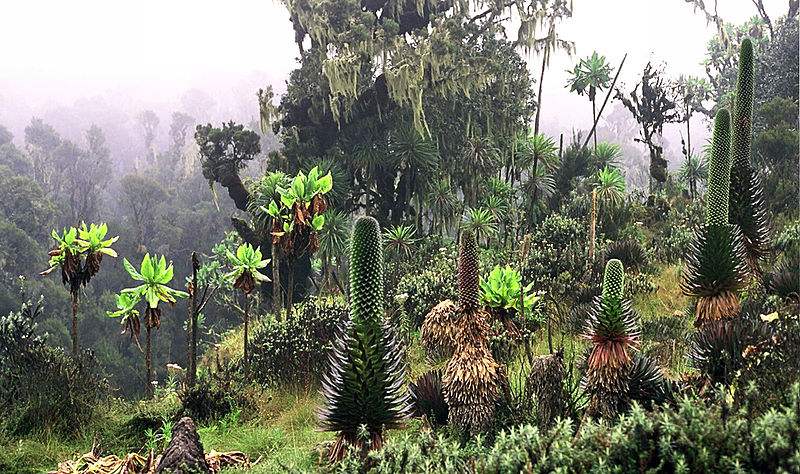 Plants in the Ruwenzori Mountains, SW Uganda, Bujuku Valley, at about 3700 m altitude. Photo by Manuel Werner, Creative Commons Attribution-Share Alike, Wikimedia |
Whilst life is no doubt widespread in the cosmos, all we know of it at present is its terran (Earth)-based form. Therefore we have "Tellurobiota", an informal name for Life on Earth, hence the quotation marks, which was coined by one of us (RFVS, ca. 2000). Which brings us to the following pages:
Life on Earth : Basic introduction to Life on Earth; which covers such essential topics as the Meaning of Life, the Facts of Life, and the Purpose of Life (or not, depending on your perspective).
Kingdoms of Life : While the number and details of kingdoms of life differ, we have decided as far as main categories go to follow an informal approach that broadly follows the The Five Kingdom paradigm of Robert Whittaker and Lynn Margulis, except that the non-technical (and by now pretty much systematically meaningless) 19th Century distinction of the animal kingdom into vertebrates and invertebrates are used.
Tree of Life : Beginning with the Master Dendrogram - more commonly but less correctly called a cladogram, although we follow cladistic principles - you can follow the evolutionary relationship of the past and present organisms, up to the major categories of life, domains and kingdoms. This brings us to the following main categories (Kingdoms of Life):
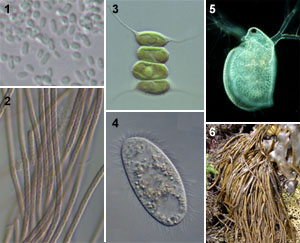 Diversity of "Tellurobiota" (Life on Earth) 1: unidentified bacteria (Bacteria). 2: Phormidium (Bacteria, NIES-507). 3: Desmodesmus (Eukarya). 4: Tetrahymena (Eukarya). 5: Ceriodaphnia (Eukarya). 6: Scytosiphon (Eukarya). Original url (includes phylogeny and basic intro) - SHIGEN; see also the Tree of Life Page |
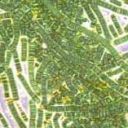 Bacteria : Bacteria (or Monera, the terminology differs, Prokaryotes is another synonym) include the simplest and oldest forms of life, such as the various types of bacteria and blue-green algae, which don't have a distinct cellular nucleus. But they are also very metabolically diverse, and able to survive extreme conditions (which make them good candidates for extraterrestrial life; i.e. if there is life elsewhere in the cosmos, of which the answer must surely be yes, the vast majority of it, just like on Earth, will quite likely be prokaryote, or else something equivalent). This section therefore is about the root and stem of the tree of life. Expect to find some good basic technical discussion, but so far not much in the way of systematic detail. It is hard to get excited by such simple life-forms. We have however adopted Carl Woese's three domain theory of life, which divides life on Earth into three primary branchs or domains: Bacteria or Eubacteria (most bacteria), Archaea (remnants from the earlier history of the earth), and Eukarya (everything else).
Bacteria : Bacteria (or Monera, the terminology differs, Prokaryotes is another synonym) include the simplest and oldest forms of life, such as the various types of bacteria and blue-green algae, which don't have a distinct cellular nucleus. But they are also very metabolically diverse, and able to survive extreme conditions (which make them good candidates for extraterrestrial life; i.e. if there is life elsewhere in the cosmos, of which the answer must surely be yes, the vast majority of it, just like on Earth, will quite likely be prokaryote, or else something equivalent). This section therefore is about the root and stem of the tree of life. Expect to find some good basic technical discussion, but so far not much in the way of systematic detail. It is hard to get excited by such simple life-forms. We have however adopted Carl Woese's three domain theory of life, which divides life on Earth into three primary branchs or domains: Bacteria or Eubacteria (most bacteria), Archaea (remnants from the earlier history of the earth), and Eukarya (everything else).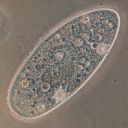 (mostly) Unicellular Eukarya : Eukarya constitutes the third domain of life on Earth, and here again for the sake of organisational simplicity and informality we have made an artificial distinction between mostly unicellular eukaryotes, including "algae", these being the more plant-like (non-motile, photosynthetic) forms, and "protozoa" which are more animal-like (motile, heterotrophic). Unfortunately or fortunately, as with the prokaryotes, the real situation regarding unicellular eukaryotes (the Protista of Whittaker and Margulis) has turned out to be far from simple, and subsequent experts in the field such as Thomas Cavalier-Smith and others have proposed various phylogenies and taxonomic schemes. The remaining Eukarya make up the three kingdoms of multicellular life of the the Whittaker-Margulis scheme.
(mostly) Unicellular Eukarya : Eukarya constitutes the third domain of life on Earth, and here again for the sake of organisational simplicity and informality we have made an artificial distinction between mostly unicellular eukaryotes, including "algae", these being the more plant-like (non-motile, photosynthetic) forms, and "protozoa" which are more animal-like (motile, heterotrophic). Unfortunately or fortunately, as with the prokaryotes, the real situation regarding unicellular eukaryotes (the Protista of Whittaker and Margulis) has turned out to be far from simple, and subsequent experts in the field such as Thomas Cavalier-Smith and others have proposed various phylogenies and taxonomic schemes. The remaining Eukarya make up the three kingdoms of multicellular life of the the Whittaker-Margulis scheme.
image, Paramecium, Wikipedia, photo by Barfooz
 Kingdom Plantae : the coverage of the more advanced Plant taxa (gymnosperms and flowering plants) is still quite basic at the time of writing).
Kingdom Plantae : the coverage of the more advanced Plant taxa (gymnosperms and flowering plants) is still quite basic at the time of writing).
image,Ferns, Wikipedia, photo Sanjay ach
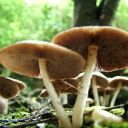 Fungi : the fungi are not quite animals and not quite plants (again we don't have that much on them, though hopefully this will change).
Fungi : the fungi are not quite animals and not quite plants (again we don't have that much on them, though hopefully this will change).
(image, Giant Mushroom, Wikimedia
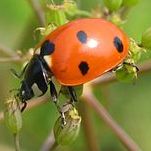 Kingdom Metazoa (Animals): Invertebrates : the Metazoa or animals are divided anthropocentrically and totally colloquially into Vertebrates and Invertebrates. Invertebrates is another way of saying all metazoa (multicellular animals) except for higher chordates. That this outmoded classification is retained is because paleontology, biology, and popular understanding still refers to animal life in terms of vertebrate and invertebrate. Mostly small, they are often overlooked in favour of their backboned brethren, although a microscope or even a hand lens will reveal creatures as astonishing as those that one might imagine would inhabit an alien world. Marine forms with hard parts have a very good fossil record, and a few these groups are covered here.
Kingdom Metazoa (Animals): Invertebrates : the Metazoa or animals are divided anthropocentrically and totally colloquially into Vertebrates and Invertebrates. Invertebrates is another way of saying all metazoa (multicellular animals) except for higher chordates. That this outmoded classification is retained is because paleontology, biology, and popular understanding still refers to animal life in terms of vertebrate and invertebrate. Mostly small, they are often overlooked in favour of their backboned brethren, although a microscope or even a hand lens will reveal creatures as astonishing as those that one might imagine would inhabit an alien world. Marine forms with hard parts have a very good fossil record, and a few these groups are covered here.
image, Ladybird Beetle, Coccinella septempunctata, Wikipedia, photo by Thomas Moertel
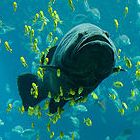 Kingdom Metazoa (Animals): Vertebrates : Vertebrates include all those large charismatic animals. Much as Palaeos started out as Toby White's Vertebrate Notes, and anyway who doesn't love ichthyosaurs, dinosaurs and other exotic Mesozoic critters? So not surprisingly this is the clade is given the most detailed coverage on these pages. image, Giant Grouper, Epinephelus lanceolatus, Wikipedia, photo by Diliff
Kingdom Metazoa (Animals): Vertebrates : Vertebrates include all those large charismatic animals. Much as Palaeos started out as Toby White's Vertebrate Notes, and anyway who doesn't love ichthyosaurs, dinosaurs and other exotic Mesozoic critters? So not surprisingly this is the clade is given the most detailed coverage on these pages. image, Giant Grouper, Epinephelus lanceolatus, Wikipedia, photo by Diliff
Life on Earth - the Highlights - 3 part very basic intro and overview of the evolution of life on Earth. (more to be added...)
| Page Back: Astrobiology | Page Up: Life in the Universe |
Page Top | Unit Home (you are here) |
Page Next: Life on Earth |
